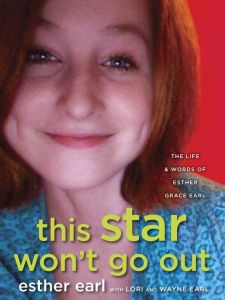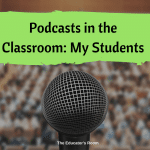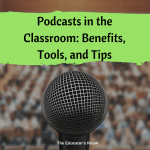 I saw the book cover on the nonfiction shelf at the library and was immediately hooked. This Star Won’t Go Out promised to fulfill the real world answers to questions swirling amongst YA followers of Fault in our Stars. The wonder and hopes that fans carry for the character heroes with terminal cancer will appreciate that Green’s FIOS dedication is Esther Earle, the star more amazing than anyone could imagine. Her story compiled from her own journals, her parents notes and reflections is a story of hope more than struggle. It is a book every educator needs to make time to read, to leave standing on their desk for others to discover.
I saw the book cover on the nonfiction shelf at the library and was immediately hooked. This Star Won’t Go Out promised to fulfill the real world answers to questions swirling amongst YA followers of Fault in our Stars. The wonder and hopes that fans carry for the character heroes with terminal cancer will appreciate that Green’s FIOS dedication is Esther Earle, the star more amazing than anyone could imagine. Her story compiled from her own journals, her parents notes and reflections is a story of hope more than struggle. It is a book every educator needs to make time to read, to leave standing on their desk for others to discover.
This biography of Esther Earle begins before her cancer is discovered, it follows her life adjustments to terminal cancer and her will to live beyond the diagnosis. John Green wrote the introduction as a measure of his long friendship with Esther and as his assertion of the influence she had on his own ideals. It is satisfying to read about students whose works inspire others, reaching beyond teen stereotypes of underachievement.This hardcore nerdfighter began a fan site, a charity project and Skype chats as a celebrated intellectual. Esther can not attend school or exercise or be in the same room with friends. She wonders if she will ever breath without her cannula or experience a first kiss. She journaled in excitement about a Wii and the physical exertion that comes from virtual sports. Online video blogging leads her to communities with friendships, laughters and her existence despite illness.
It was the moment in this reading that I realized how important it is for all current educators to follow Esther’s story. To be anything you want to be without judgement is powerful for all youth. Everyone struggles with identities that have already been placed or determined and to define your own, well this is what the internet offers. Esther wanted to be anyone but a girl with terminal cancer. She wanted to transcend her illness and be normal for her limited lifetime. Thus she helps design Catitude- a shared journaling space online peers. Eventually, they will discover her illness but are the first people to know her as a healthy and happy teen. John Green described this by noting, “we live in a world defined by boundaries. But the miracle and hope of human consciousness is that we still can conceive of boundlessness.”
Educators are constantly bombarded by administrators, media and parental anxieties about the dangers of social media. We attend trainings on controlling use of technology, locking applications but are rarely trained on how to utilize chat groups or social media. A Catitude peer, Arka Pain, sums up the significance of the online friendships in one chapter. “Our group of friends went from jokes and random nerd enthusiasm, which bears no fault in itself, to becoming a safe, comforting online spaces of love and compassion. Before I had met Esther, I didn’t think of the Internet as the kind of medium for friends to spill their souls… I couldn’t have imagined I would get to know online friends just as well as friends I see every day.”
This story began to outline for me, the fact that the internet became a sort of drawing board for writing, video, and artistic expression. It was sloppy and imperfect but transforms with practice. The safety of an internet community gave each individual the space they needed to improve their storytelling and their purpose, their contributions without ridicule or criticisms. I can’t say that the same environment exists in regular schools where the goal is to document, re evaluated and critique students daily. Work is measured by levels of success or failure. Yet Esther and her friends were driven to design and develop authentic spaces for thought.
I know that this book was also a documentation of a family’s struggle to survive the inextricable pain and death of a teenage daughter with love and hope. The reader is guided through her sudden illness, rapid diagnosis and years of survival in oncology communities. In the midst of pain, Ether interjects sincerity and humor in regards to concern for a sister.”she came with me when I got my g-tube switched, and held my hand as they freaking pulled the life out of me (I could be exaggerating a little)..”
My educator persona reflects on the difficulty of understanding what children think in the most trying circumstance. We can’t know how they balance the surreal expectations of school with the constant needs within their home. How do we score the prose, the raw edge, the humor and depth of emotion that students encounter on a daily basis? I was reminded that students need opportunities to publish that natural humor, that sincerity. They need opportunities to practice being, amazing or “awesome” in order to become so. And teens are incredibly creative, to the point of heartbreak. Esther’s Futureme.org written for her parents a year before she died was a perceptive voice of reason, assuring that the financial woes, the anxieties were her own.
This compilation of the community struggling to keep a young adult alive and happy has me examining the own health of my classrooms and communities. Do I provide opportunities for students to dream? To be awesome? To take risks? In the era of education based on data analysis and grades directly connected to Common Core Standards it could never be more important to set aside time to find joy, love or hope in everyday moments. Without possibility there is no purpose.





